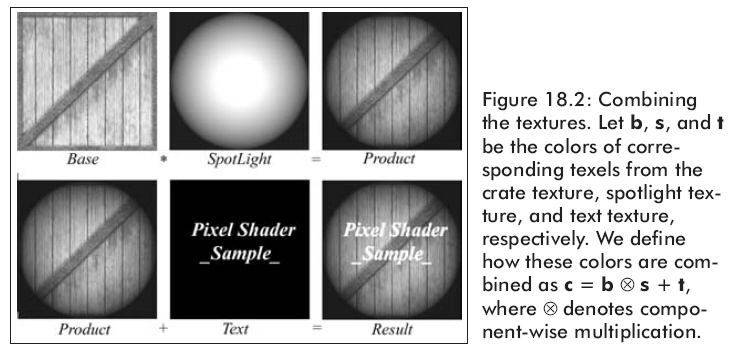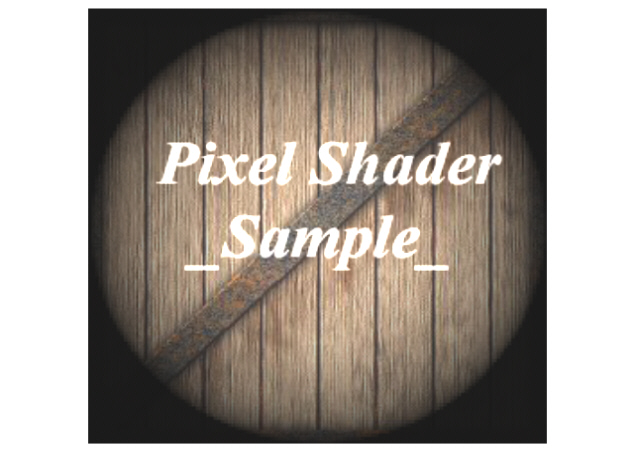新建网页 1
在像素着色器中使用HLSL的内建函数tex*XXXX给纹理采样。注意:采样时引用纹理上图素的坐标索引和采样器状态来生成像素。
通常这些函数需要我们做2件事:
使用纹理中的索引建立(u, v)纹理坐标。
给特定的纹理中编入索引。
将纹理坐标(u, v)输入到像素着色器,在一个指定的HLSL对象中的像素着色器中,我们想编入索引的纹理是在像素着色器中被定义过的,在HLSL中叫作采样器。(The particular texture that we want to index into is identified in the pixel shader by a special HLSL object called a sampler.),我们可以把采样器对象想象成定义纹理和采样器阶段的对象。例如:假如我们使用3张纹理,这意味着我们需要在像素着色器里能够引用3个阶段中的每个一个。在像素着色器中我们这样写:
|
sampler FirstTex;
sampler SecondTex;
sampler ThirdTex;
|
Direct3D将给每个采样器对象连接一个唯一的纹理级别(stage),在应用程序中我们找出与采样器对象相关联的阶段,并设置相应的纹理和采样器状态给该阶段。下列代码将举例说明如何在应用程序中设置纹理并把采样器状态设置为FirstTex:
// 创建
IDirect3DTexture9* Tex;
D3DXCreateTextureFromFile(Device, "tex.bmp", &Tex);
… …
// 取得常量FirstTex的句柄
FirstTexHandle = MultiTexCT->GetConstantByName(0, "FirstTex");
// 取得常量的描述
D3DXCONSTANT_DESC FirstTexDesc;
UINT count;
MultiTexCT->GetConstantDesc(FirstTexHandle, &FirstTexDesc, &count);
… …
// 为FirstTex设置纹理和采样器状态.
// We identify the stage FirstTex is associated with from the D3DXCONSTANT_DESC::RegisterIndex member:
Device->SetTexture(FirstTexDesc.RegisterIndex, Tex);
Device->SetSamplerState(FirstTexDesc.RegisterIndex, D3DSAMP_MAGFILTER, D3DTEXF_LINEAR);
Device->SetSamplerState(FirstTexDesc.RegisterIndex, D3DSAMP_MINFILTER, D3DTEXF_LINEAR);
Device->SetSamplerState(FirstTexDesc.RegisterIndex, D3DSAMP_MIPFILTER, D3DTEXF_LINEAR);
|
注意:作为选择,替换使用采样器类型,你可以使用更多特殊的、强大的类型,如:sampler1D,sampler2D,sampler3D,和samplerCube类型,这些类型更安全并且它们只使用tex*函数。例如:一个sampler2D对象只使用tex2D*函数,同样一个sampler3D对象只使用tex3D*函数。
18.5例子程序:Multitexturing in a Pixel Shader
这章中的例子演示了在像素着色器中使用多纹理,这个例子渲染的目标是一个木箱纹理,一个聚光灯纹理,和一个包含字符串的纹理。这就是例子程序:Pixel Shader。

这个例子可以不使用像素着色器来实现,但实现这个程序是简单直接,它允许我们示范如何编写,创建,而且使用像素着色器实现一些特效不必使用那些复杂的算法。
虽然在这个例子中一次只使用3张纹理,检查采样器对象的成员以确定每个像素着色器能够使用的版本,这是值得的。换句话说,我们一次能使用多少纹理,这依赖于使用的像素着色器的版本:
像素着色器的版本ps_1_1到 ps_1_3支持4个纹理采样器。
像素着色器的版本ps_1_4支持6个纹理采样器。
像素着色器的版本ps_2_0到 ps_3_0支持16个纹理采样器。
/******************************************************************************
Pixel shader that does multi texturing.
******************************************************************************/
sampler g_base_texture;
sampler g_spotlight_texture;
sampler g_string_texture;
struct sPixelInput
{
float2 base : TEXCOORD0;
float2 spotlight : TEXCOORD1;
float2 text : TEXCOORD2;
};
struct sPixelOutput
{
vector diffuse : COLOR0;
};
/////////////////////////////////////////////////////////////////////////////////
sPixelOutput main(sPixelInput input)
{
sPixelOutput output = (sPixelOutput) 0;
// sample appropriate textures
vector base_color = tex2D(g_base_texture, input.base);
vector spotlight_color = tex2D(g_spotlight_texture, input.spotlight);
vector text_color = tex2D(g_string_texture, input.text);
// combine texel colors
vector color = base_color * spotlight_color + text_color;
// increase the intensity of the pixel slightly
color += 0.1f;
// save the resulting pixel color
output.diffuse = color;
return output;
}
tex2D的函数使用说明如下:
There are two overloaded tex2D texture lookup functions:
- 2D texture lookup
- 2D texture lookup with partial derivatives
2D texture lookup
This function performs a 2D texture lookup.
Syntax
Where:
| Name | In/Out | Template Type | Component Type | Size |
| s |
in |
object |
sampler2D |
1 |
| t |
in |
vector |
float |
2 |
| ret |
out |
vector |
float |
4 |
2D texture lookup with partial derivatives
This function performs a 2D texture lookup also, but also uses the partial derivatives to help pick the LOD.
Syntax
| ret tex2D(s, t, ddx, ddy) |
Where:
| Name | In/Out | Template Type | Component Type | Size |
| s |
in |
object |
sampler2D |
1 |
| t |
in |
vector |
float |
2 |
| ddx |
in |
vector |
float |
2 |
| ddy |
in |
vector |
float |
2 |
| ret |
out |
vector |
float |
4 |
首先像素着色器定义了3个sampler对象,要渲染的每个纹理,接下来定义是input和output结构。注意:我们没有将任何的颜色值输入到像素着色器中,这是因为我们使用纹理自己的颜色和光照;即BaseTex保存表面的颜色,SpotLightTex是光照图。像素着色器输出只一个简颜色值,指定了我们计算过的这个特定像素的颜色。
Main函数使用tex2D函数采样3个纹理,即它取得每个纹理的图素,计算映射到的像素,这通常依赖于指定的纹理坐标和采样器对象。然后我们混合图素的颜色用公式:c = b * s + t。接下来我们让全部的像素变亮一个bit,给每个部分增加0.1f。最后我们保存结果像素颜色并返回它。
执行程序:
/**************************************************************************************************
Deomstrates multi-texturing using a pixel shader. You will have to switch to the REF
device to run this sample if your hardware doesn't support pixel shaders.
**************************************************************************************************/
#include "d3dUtility.h"
#pragma warning(disable : 4100)
struct sMultiTextureVertex
{
sMultiTextureVertex(float x, float y, float z,
float u0, float v0,
float u1, float v1,
float u2, float v2)
{
_x = x; _y = y; _z = z;
_u0 = u0; _v0 = v0;
_u1 = u1; _v1 = v1;
_u2 = u2, _v2 = v2;
}
float _x, _y, _z;
float _u0, _v0;
float _u1, _v1;
float _u2, _v2;
};
const DWORD MULTI_TEXTURE_VERTEX_FVF = D3DFVF_XYZ | D3DFVF_TEX3;
/////////////////////////////////////////////////////////////////////////////////////////////
const int WIDTH = 640;
const int HEIGHT = 480;
IDirect3DDevice9* g_device;
IDirect3DPixelShader9* g_pixel_shader;
ID3DXConstantTable* g_constant_table;
IDirect3DVertexBuffer9* g_vertex_buffer;
IDirect3DTexture9* g_base_texture;
IDirect3DTexture9* g_spotlight_texture;
IDirect3DTexture9* g_string_texture;
D3DXHANDLE g_base_texture_handle;
D3DXHANDLE g_spotlight_texture_handle;
D3DXHANDLE g_string_texture_handle;
D3DXCONSTANT_DESC g_base_texture_desc;
D3DXCONSTANT_DESC g_spotlight_texture_desc;
D3DXCONSTANT_DESC g_string_texture_desc;
////////////////////////////////////////////////////////////////////////////////////////////////////
bool setup()
{
// create geometry
g_device->CreateVertexBuffer(6 * sizeof(sMultiTextureVertex), D3DUSAGE_WRITEONLY,
MULTI_TEXTURE_VERTEX_FVF, D3DPOOL_MANAGED, &g_vertex_buffer, NULL);
sMultiTextureVertex* v;
g_vertex_buffer->Lock(0, 0, (void**)&v, 0);
v[0] = sMultiTextureVertex(-10.0f, -10.0f, 5.0f, 0.0f, 1.0f, 0.0f, 1.0f, 0.0f, 1.0f);
v[1] = sMultiTextureVertex(-10.0f, 10.0f, 5.0f, 0.0f, 0.0f, 0.0f, 0.0f, 0.0f, 0.0f);
v[2] = sMultiTextureVertex( 10.0f, 10.0f, 5.0f, 1.0f, 0.0f, 1.0f, 0.0f, 1.0f, 0.0f);
v[3] = sMultiTextureVertex(-10.0f, -10.0f, 5.0f, 0.0f, 1.0f, 0.0f, 1.0f, 0.0f, 1.0f);
v[4] = sMultiTextureVertex( 10.0f, 10.0f, 5.0f, 1.0f, 0.0f, 1.0f, 0.0f, 1.0f, 0.0f);
v[5] = sMultiTextureVertex( 10.0f, -10.0f, 5.0f, 1.0f, 1.0f, 1.0f, 1.0f, 1.0f, 1.0f);
g_vertex_buffer->Unlock();
// compile shader
ID3DXBuffer* shader_buffer;
ID3DXBuffer* error_buffer;
HRESULT hr = D3DXCompileShaderFromFile("MultiTextureShader.cxx", NULL, NULL, "main", "ps_2_0", D3DXSHADER_DEBUG,
&shader_buffer, &error_buffer, &g_constant_table);
// output any error messages
if(error_buffer)
{
MessageBox(NULL, (char*) error_buffer->GetBufferPointer(), "ERROR", MB_OK);
safe_release<ID3DXBuffer*>(error_buffer);
}
if(FAILED(hr))
{
MessageBox(NULL, "D3DXCompileShaderFromFile() - FAILED", "ERROR", MB_OK);
return false;
}
hr = g_device->CreatePixelShader((DWORD*) shader_buffer->GetBufferPointer(), &g_pixel_shader);
if(FAILED(hr))
{
MessageBox(NULL, "CreatePixelShader - FAILED", "ERROR", MB_OK);
return false;
}
safe_release<ID3DXBuffer*>(shader_buffer);
// load textures
D3DXCreateTextureFromFile(g_device, "crate.bmp", &g_base_texture);
D3DXCreateTextureFromFile(g_device, "spotlight.bmp", &g_spotlight_texture);
D3DXCreateTextureFromFile(g_device, "text.bmp", &g_string_texture);
// get handles
g_base_texture_handle = g_constant_table->GetConstantByName(NULL, "g_base_texture");
g_spotlight_texture_handle = g_constant_table->GetConstantByName(NULL, "g_spotlight_texture");
g_string_texture_handle = g_constant_table->GetConstantByName(NULL, "g_string_texture");
// set constant descriptions
UINT count;
g_constant_table->GetConstantDesc(g_base_texture_handle, &g_base_texture_desc, &count);
g_constant_table->GetConstantDesc(g_spotlight_texture_handle, &g_spotlight_texture_desc, &count);
g_constant_table->GetConstantDesc(g_string_texture_handle, &g_string_texture_desc, &count);
g_constant_table->SetDefaults(g_device);
// set the projection matrix
D3DXMATRIX proj;
D3DXMatrixPerspectiveFovLH(&proj, D3DX_PI/4.0f, (float)WIDTH/HEIGHT, 1.0f, 1000.0f);
g_device->SetTransform(D3DTS_PROJECTION, &proj);
//g_device->SetRenderState(D3DRS_FILLMODE, D3DFILL_WIREFRAME);
return true;
}
///////////////////////////////////////////////////////////////////////////////////////////////////////
void cleanup()
{
safe_release<IDirect3DVertexBuffer9*>(g_vertex_buffer);
safe_release<IDirect3DTexture9*>(g_base_texture);
safe_release<IDirect3DTexture9*>(g_spotlight_texture);
safe_release<IDirect3DTexture9*>(g_string_texture);
safe_release<IDirect3DPixelShader9*>(g_pixel_shader);
safe_release<ID3DXConstantTable*>(g_constant_table);
}
///////////////////////////////////////////////////////////////////////////////////////////////////////
bool display(float time_delta)
{
// update the scene: allow user to rotate around scene.
static float angle = (3.0f * D3DX_PI) / 2.0f;
static float radius = 20.0f;
if(GetAsyncKeyState(VK_LEFT) & 0x8000f)
angle -= 0.5f * time_delta;
if(GetAsyncKeyState(VK_RIGHT) & 0x8000f)
angle += 0.5f * time_delta;
if(GetAsyncKeyState(VK_UP) & 0x8000f)
radius -= 2.0f * time_delta;
if(GetAsyncKeyState(VK_DOWN) & 0x8000f)
radius += 2.0f * time_delta;
D3DXVECTOR3 position(cosf(angle) * radius, 0.0f, sinf(angle) * radius);
D3DXVECTOR3 target(0.0f, 0.0f, 0.0f);
D3DXVECTOR3 up(0.0f, 1.0f, 0.0f);
D3DXMATRIX view_matrix;
D3DXMatrixLookAtLH(&view_matrix, &position, &target, &up);
g_device->SetTransform(D3DTS_VIEW, &view_matrix);
// render now
g_device->Clear(0, NULL, D3DCLEAR_TARGET | D3DCLEAR_ZBUFFER, 0xFFFFFFFF, 1.0f, 0);
g_device->BeginScene();
g_device->SetPixelShader(g_pixel_shader);
g_device->SetFVF(MULTI_TEXTURE_VERTEX_FVF);
g_device->SetStreamSource(0, g_vertex_buffer, 0, sizeof(sMultiTextureVertex));
// base texture
g_device->SetTexture(g_base_texture_desc.RegisterIndex, g_base_texture);
g_device->SetSamplerState(g_base_texture_desc.RegisterIndex, D3DSAMP_MAGFILTER, D3DTEXF_LINEAR);
g_device->SetSamplerState(g_base_texture_desc.RegisterIndex, D3DSAMP_MINFILTER, D3DTEXF_LINEAR);
g_device->SetSamplerState(g_base_texture_desc.RegisterIndex, D3DSAMP_MIPFILTER, D3DTEXF_LINEAR);
// spotlight texture
g_device->SetTexture(g_spotlight_texture_desc.RegisterIndex, g_spotlight_texture);
g_device->SetSamplerState(g_spotlight_texture_desc.RegisterIndex, D3DSAMP_MAGFILTER, D3DTEXF_LINEAR);
g_device->SetSamplerState(g_spotlight_texture_desc.RegisterIndex, D3DSAMP_MINFILTER, D3DTEXF_LINEAR);
g_device->SetSamplerState(g_spotlight_texture_desc.RegisterIndex, D3DSAMP_MIPFILTER, D3DTEXF_LINEAR);
// string texture
g_device->SetTexture(g_string_texture_desc.RegisterIndex, g_string_texture);
g_device->SetSamplerState(g_string_texture_desc.RegisterIndex, D3DSAMP_MAGFILTER, D3DTEXF_LINEAR);
g_device->SetSamplerState(g_string_texture_desc.RegisterIndex, D3DSAMP_MINFILTER, D3DTEXF_LINEAR);
g_device->SetSamplerState(g_string_texture_desc.RegisterIndex, D3DSAMP_MIPFILTER, D3DTEXF_LINEAR);
g_device->DrawPrimitive(D3DPT_TRIANGLELIST, 0, 2);
g_device->EndScene();
g_device->Present(NULL, NULL, NULL, NULL);
return true;
}
///////////////////////////////////////////////////////////////////////////////////////////////////////
LRESULT CALLBACK wnd_proc(HWND hwnd, UINT msg, WPARAM word_param, LPARAM long_param)
{
switch(msg)
{
case WM_DESTROY:
PostQuitMessage(0);
break;
case WM_KEYDOWN:
if(word_param == VK_ESCAPE)
DestroyWindow(hwnd);
break;
}
return DefWindowProc(hwnd, msg, word_param, long_param);
}
///////////////////////////////////////////////////////////////////////////////////////////////////////
int WINAPI WinMain(HINSTANCE inst, HINSTANCE, PSTR cmd_line, int cmd_show)
{
if(! init_d3d(inst, WIDTH, HEIGHT, true, D3DDEVTYPE_HAL, &g_device))
{
MessageBox(NULL, "init_d3d() - failed.", 0, MB_OK);
return 0;
}
if(! setup())
{
MessageBox(NULL, "Steup() - failed.", 0, MB_OK);
return 0;
}
enter_msg_loop(display);
cleanup();
g_device->Release();
return 0;
}
setup函数执行下列功能:
填充方形的顶点缓存
编译着像素色器
创建像素色器
读取纹理
设置投影矩阵,不使用光照
取得采样器(sampler)对象的句柄
取得采样器对象的描述
display函数设置像素着色器,使用2个纹理,并且在渲染方格前设置他们对应的采样器状态。
运行截图:

下载源程序